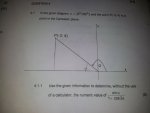Hi, this is my first post, so sorry for anything I do wrong 
I have gotten a previous math exam to do for homework and I'm having trouble figuring out what to do
Given: a diagram that has an angle x, a point P(-3;4) that is extended to the origin
I need to, without using a calculator, find the numeric value of: (sinx)/(1 + cos2x)
The angle x is toward the right of the PO line. I've no clue what to do after finding the value of x, which I found to be 126,87 degrees.
Any help will be much appreciated
I said the angle was 'x' because I don't have(know how to get) that symbol on my keyboard

I have gotten a previous math exam to do for homework and I'm having trouble figuring out what to do
Given: a diagram that has an angle x, a point P(-3;4) that is extended to the origin
I need to, without using a calculator, find the numeric value of: (sinx)/(1 + cos2x)
The angle x is toward the right of the PO line. I've no clue what to do after finding the value of x, which I found to be 126,87 degrees.
Any help will be much appreciated
I said the angle was 'x' because I don't have(know how to get) that symbol on my keyboard

